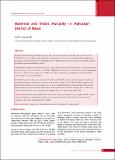Please use this identifier to cite or link to this item:
https://hdl.handle.net/20.500.14356/2010Full metadata record
| DC Field | Value | Language |
|---|---|---|
| dc.contributor.author | Maskey, M K | - |
| dc.contributor.author | Shah, R | - |
| dc.contributor.author | Shah, R | - |
| dc.date.accessioned | 2023-06-05T09:25:44Z | - |
| dc.date.available | 2023-06-05T09:25:44Z | - |
| dc.date.issued | 2010 | - |
| dc.identifier.citation | MaskeyM. K., ShahR., & ShahR. (2010). Maternal and Infant Mortality in Mahottari District of Nepal. Journal of Nepal Health Research Council. https://doi.org/10.33314/jnhrc.v0i0.221 | en_US |
| dc.identifier.issn | Print ISSN: 1727-5482; Online ISSN: 1999-6217 | - |
| dc.identifier.uri | http://103.69.126.140:8080/handle/20.500.14356/2010 | - |
| dc.description | Original Article | en_US |
| dc.description.abstract | Abstract Background: Reducing maternal mortality by three quarters and under-five mortality by two-thirds between 1990 and 2015 are the targets of UN Millennium Development Goals as well as of the national safe motherhood programme of Nepal. This study was undertaken by Nepal Health Research Council mainly to identify the maternal and infant mortalities in Mahottari district. Methods: A descriptive observational study was carried out of maternal and child death over two year period before the time of survey was carried out in eleven VDCs of Mahottari District and two wards of the Jaleshwor municipality. Data were collected in three stages: first, FCHVs collected the information regarding birth, maternal and infant death, which were cross-checked later.       Results: Maternal mortality ratio was estimated at 380 per 100,000 live births, and early neonatal mortality rate, neonatal mortality rate and infant mortality rate were found 32, 39 and 52per 1,000 live births respectively. The highest deaths in infants were among Dalits, whereas it was among Muslims for maternal mortality. All maternal deaths occurred at a distance of more than 2 hours. Male-to-female ratio for infant mortality was 1:3. The major cause of maternal deaths was post-partum haemorrhage, while it was sepsis among infant deaths. Conclusions: Both maternal mortality ratio and infant mortality rate of the district were higher than the national average and appeared commensurate with the socio-economic  status and health facilities of the district when compared with another similar Terai district of Bara. Key words: infant mortality rate, maternal mortality ratio, millennium development goals | en_US |
| dc.language.iso | en | en_US |
| dc.publisher | Nepal Health Research Council | en_US |
| dc.relation.ispartofseries | April;221 | - |
| dc.subject | Infant mortality rate | en_US |
| dc.subject | Maternal mortality ratio | en_US |
| dc.subject | Millennium development goals | en_US |
| dc.title | Maternal and Infant Mortality in Mahottari District of Nepal | en_US |
| dc.type | Journal Article | en_US |
| local.journal.category | Original Article | - |
| Appears in Collections: | Vol 8 No 1 Issue 16 April 2010 | |
Files in This Item:
| File | Description | Size | Format | |
|---|---|---|---|---|
| 221-Article Text-219-1-10-20130822.pdf | Fulltext Download | 208.15 kB | Adobe PDF |  View/Open |
Items in DSpace are protected by copyright, with all rights reserved, unless otherwise indicated.
